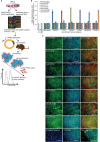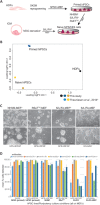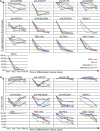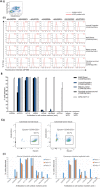New Monoclonal Antibodies to Defined Cell Surface Proteins on Human Pluripotent Stem Cells
- PMID: 28009074
- PMCID: PMC5412944
- DOI: 10.1002/stem.2558
New Monoclonal Antibodies to Defined Cell Surface Proteins on Human Pluripotent Stem Cells
Abstract
The study and application of human pluripotent stem cells (hPSCs) will be enhanced by the availability of well-characterized monoclonal antibodies (mAbs) detecting cell-surface epitopes. Here, we report generation of seven new mAbs that detect cell surface proteins present on live and fixed human ES cells (hESCs) and human iPS cells (hiPSCs), confirming our previous prediction that these proteins were present on the cell surface of hPSCs. The mAbs all show a high correlation with POU5F1 (OCT4) expression and other hPSC surface markers (TRA-160 and SSEA-4) in hPSC cultures and detect rare OCT4 positive cells in differentiated cell cultures. These mAbs are immunoreactive to cell surface protein epitopes on both primed and naive state hPSCs, providing useful research tools to investigate the cellular mechanisms underlying human pluripotency and states of cellular reprogramming. In addition, we report that subsets of the seven new mAbs are also immunoreactive to human bone marrow-derived mesenchymal stem cells (MSCs), normal human breast subsets and both normal and tumorigenic colorectal cell populations. The mAbs reported here should accelerate the investigation of the nature of pluripotency, and enable development of robust cell separation and tracing technologies to enrich or deplete for hPSCs and other human stem and somatic cell types. Stem Cells 2017;35:626-640.
Keywords: Breast; Cancer; Cell surface markers; Colorectal; Human embryonic stem cells; Human iPS cells; Monoclonal antibodies; Naive; Pluripotency.
© 2016 The Authors Stem Cells published by Wiley Periodicals, Inc. on behalf of AlphaMed Press.
Figures





Similar articles
-
Bone marrow stromal cell antigen 2 is broadly expressed in the different pluripotent states of human pluripotent stem cells and regulates the expression of pluripotency genes and three germ layer markers.Hum Cell. 2024 Dec 24;38(1):34. doi: 10.1007/s13577-024-01160-0. Hum Cell. 2024. PMID: 39718725
-
Development of a decoy immunization strategy to identify cell-surface molecules expressed on undifferentiated human embryonic stem cells.Cell Tissue Res. 2008 Aug;333(2):197-206. doi: 10.1007/s00441-008-0632-6. Epub 2008 Jun 17. Cell Tissue Res. 2008. PMID: 18560898
-
Progesterone Receptor Membrane Component 1 suppresses the p53 and Wnt/β-catenin pathways to promote human pluripotent stem cell self-renewal.Sci Rep. 2018 Feb 14;8(1):3048. doi: 10.1038/s41598-018-21322-z. Sci Rep. 2018. PMID: 29445107 Free PMC article.
-
Cell surface markers for the identification and study of human naive pluripotent stem cells.Stem Cell Res. 2018 Jan;26:36-43. doi: 10.1016/j.scr.2017.11.017. Epub 2017 Dec 2. Stem Cell Res. 2018. PMID: 29227830 Review.
-
The application of cell surface markers to demarcate distinct human pluripotent states.Exp Cell Res. 2020 Feb 1;387(1):111749. doi: 10.1016/j.yexcr.2019.111749. Epub 2019 Nov 30. Exp Cell Res. 2020. PMID: 31790696 Free PMC article. Review.
Cited by
-
Development of a High-Efficacy Reprogramming Method for Generating Human Induced Pluripotent Stem (iPS) Cells from Pathologic and Senescent Somatic Cells.Int J Mol Sci. 2020 Sep 15;21(18):6764. doi: 10.3390/ijms21186764. Int J Mol Sci. 2020. PMID: 32942642 Free PMC article.
-
Comprehensive characterization of distinct states of human naive pluripotency generated by reprogramming.Nat Methods. 2017 Nov;14(11):1055-1062. doi: 10.1038/nmeth.4436. Epub 2017 Sep 25. Nat Methods. 2017. PMID: 28945704
-
Benchmarking of ATAC Sequencing Data From BGI's Low-Cost DNBSEQ-G400 Instrument for Identification of Open and Occupied Chromatin Regions.Front Mol Biosci. 2022 Jul 7;9:900323. doi: 10.3389/fmolb.2022.900323. eCollection 2022. Front Mol Biosci. 2022. PMID: 35874611 Free PMC article.
-
Photoinduced reconfiguration to control the protein-binding affinity of azobenzene-cyclized peptides.J Mater Chem B. 2020 Aug 26;8(33):7413-7427. doi: 10.1039/d0tb01189d. J Mater Chem B. 2020. PMID: 32661544 Free PMC article.
-
Desmoglein 2 regulates cardiogenesis by restricting hematopoiesis in the developing murine heart.Sci Rep. 2021 Nov 4;11(1):21687. doi: 10.1038/s41598-021-00996-y. Sci Rep. 2021. PMID: 34737300 Free PMC article.
References
-
- Thomson JA, Itskovitz‐Eldor J, Shapiro SS et al. Embryonic stem cell lines derived from human blastocysts. Science 1998;282:1145–1147. - PubMed
-
- Yu J, Vodyanik MA, Smuga‐Otto K et al. Induced pluripotent stem cell lines derived from human somatic cells. Science 2007;318:1917–1920. - PubMed
-
- Takahashi K, Tanabe K, Ohnuki M et al. Induction of pluripotent stem cells from adult human fibroblasts by defined factors. Cell 2007;131:861–872. - PubMed

